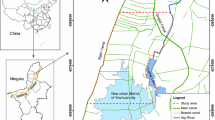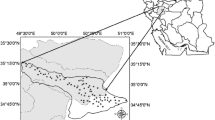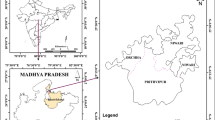Abstract
Groundwater contamination assessment is a challenging task due to inherent complex dynamisms associated with the groundwater. DRASTIC is a very widely used rapid regional tool for the assessment of vulnerability of groundwater to contamination. DRASTIC has many lacunas in the form of subjectivities associated with weights and ratings of its hydro-geological parameters, and, therefore, the accuracy of the DRASTIC-based vulnerability map is questioned. The present study demonstrates the optimisation of the DRASTIC parameters along with a scientific consideration to the anthropogenic factors causing groundwater contamination. The resulting scientific consistent weights and ratings to DRASTIC parameters assist in the development of a very precise groundwater vulnerability map highlighting different zones of different gravity of contamination. One of the most important aspects of this study is that we have considered the impact of vadose zone in a very comprehensive manner by considering every sub-surface layer from the earth surface to the occurrence of groundwater. The study area for our experiment is Fatehgarh Sahib district of Punjab which is facing several groundwater issues.















Similar content being viewed by others
References
Aller, B. T., Lehar, J. H., & Petty, R. (1987). DRASTIC: a standardized system to evaluate ground water pollution potential using hydrogeologic settings. National Water Well Association Worthington: Ohio.
Alonso, J. A., & Lamata, M. T. (2006). Consistency in the analytic hierarchy process: a new approach. International Journal of Uncertainty, Fuzziness and Knowledge-Based Systems, 14(04), 445–459.
Arezoomand Omidi Langrudi, M., Khashei Siuki, A., Javadi, S., & Hashemi, S. R. (2016). Evaluation of vulnerability of aquifers by improved fuzzy drastic method: case study: Aastane Kochesfahan plain in Iran. Ain Shams Engineering Journal, 7(1), 11–20.
Ayele, G. T., S. S. Demessie, K. T. Mengistu, S. A. Tilahun and A. M. Melesse (2016). Multitemporal land use/land cover change detection for the Batena Watershed, Rift Valley Lakes Basin, Ethiopia. Landscape dynamics, soils and hydrological processes in varied climates. M. A. Melesse and W. Abtew. Cham, Springer International Publishing: 51–72.
Bai, L., Wang, Y., & Meng, F. (2012). Application of DRASTIC and extension theory in the groundwater vulnerability evaluation. Water Environment Journal, 26(3), 381–391.
Bureau of Indian Standards (2012). Drinking water — Specification. New Delhi, BIS: 11.
Chawla, P., P. Kumar, M. Singh, N. Hasteer and C. Ghanshyam (2015). Prediction of pollution potential of Indian rivers using empirical equation consisting of water quality parameters. Technological Innovation in ICT for Agriculture and Rural Development (TIAR), 2015 IEEE.
Chenini, I., Zghibi, A., & Kouzana, L. (2015). Hydrogeological investigations and groundwater vulnerability assessment and mapping for groundwater resource protection and management: state of the art and a case study. Journal of African Earth Sciences, 109, 11–26.
Directorate of census operations (2011). District census Handbook Fatehgarh Sahib. Punjab. 4.
Gogu, C. R., & Dassargues, A. (2000). Current trends and future challenges in groundwater vulnerability assessment using overlay and index methods. Environmental Geology, 39(6), 549–559.
Halder, S., Saha, S. K., Dirmeyer, P. A., Chase, T. N., & Goswami, B. N. (2016). Investigating the impact of land-use land-cover change on Indian summer monsoon daily rainfall and temperature during 1951–2005 using a regional climate model. Hydrology and Earth System Sciences, 20(5), 1765–1784.
Hamutoko, J. T., Wanke, H., & Voigt, H. J. (2016). Estimation of groundwater vulnerability to pollution based on DRASTIC in the Niipele sub-basin of the Cuvelai Etosha Basin, Namibia. Physics and Chemistry of the Earth, Parts A/B/C, 93, 46–54.
Huan, H., Wang, J., & Teng, Y. (2012). Assessment and validation of groundwater vulnerability to nitrate based on a modified DRASTIC model: a case study in Jilin City of northeast China. Science of the Total Environment, 440, 14–23.
Huang, I. B., Keisler, J., & Linkov, I. (2011). Multi-criteria decision analysis in environmental sciences: ten years of applications and trends. Science of the Total Environment, 409(19), 3578–3594.
Iqbal, J., Gorai, A. K., Katpatal, Y. B., & Pathak, G. (2015). Development of GIS-based fuzzy pattern recognition model (modified DRASTIC model) for groundwater vulnerability to pollution assessment. International journal of Environmental Science and Technology, 12(10), 3161–3174.
Jarvis, A., H. I. Reuter, A. Nelson and E. Guevara (2008). “Hole-filled SRTM for the globe Version 4.” available from the CGIAR-CSI SRTM 90m Database (http://srtm.csi.cgiar.org).
Jiang, Y., Wu, Y., Groves, C., Yuan, D., & Kambesis, P. (2009). Natural and anthropogenic factors affecting the groundwater quality in the Nandong karst underground river system in Yunan, China. Journal of Contaminant Hydrology, 109(1), 49–61.
Kalinski, R. J., Kelly, W. E., Bogardi, I., Ehrman, R. L., & Yaniamoto, P. D. (1994). Correlation between DRASTIC vulnerabilities and incidents of VOC contamination of municipal wells in Nebraska. Groundwater, 32(1), 31–34.
Kang, J., L. Zhao, R. Li, H. Mo and Y. Li (2016). “Groundwater vulnerability assessment based on modified DRASTIC model: a case study in Changli County, China.” Geocarto International: 1–10.
Karkra, R., P. Kumar, B. K. S. Bansod, S. Bagchi, P. Sharma and C. R. Krishna (2016a). "Classification of heavy metal ions present in multi-frequency multi-electrode potable water data using evolutionary algorithm." Applied Water Science.
Karkra, R., Kumar, P., Bansod, B. K. S., & Krishna, C. R. (2016b). Analysis of heavy metal ions in potable water using soft computing technique. Procedia Computer Science, 93, 988–994.
Kätterer, T., Fabião, A., Madeira, M., Ribeiro, C., & Steen, E. (1995). Fine-root dynamics, soil moisture and soil carbon content in a Eucalyptus globulus plantation under different irrigation and fertilisation regimes. Forest Ecology and Management, 74(1), 1–12.
Kazakis, N., & Voudouris, K. S. (2015). Groundwater vulnerability and pollution risk assessment of porous aquifers to nitrate: modifying the DRASTIC method using quantitative parameters. Journal of Hydrology, 525, 13–25.
Khatri, N., & Tyagi, S. (2015). Influences of natural and anthropogenic factors on surface and groundwater quality in rural and urban areas. Frontiers in Life Science, 8(1), 23–39.
Krishna, R., Iqbal, J., Gorai, A. K., Pathak, G., Tuluri, F., & Tchounwou, P. B. (2015). Groundwater vulnerability to pollution mapping of Ranchi district using GIS. Applied Water Science, 5(4), 345–358.
Kumar, M., Kumari, K., Ramanathan, A., & Saxena, R. (2007). A comparative evaluation of groundwater suitability for irrigation and drinking purposes in two intensively cultivated districts of Punjab, India. Environmental Geology, 53(3), 553–574.
Kumar, P., Bansod, B. K. S., Debnath, S. K., Thakur, P. K., & Ghanshyam, C. (2015). Index-based groundwater vulnerability mapping models using hydrogeological settings: a critical evaluation. Environmental Impact Assessment Review, 51, 38–49.
Kumar, P., Bhondekar, A. P., & Kapur, P. (2012). Modelling and estimation of spatiotemporal surface dynamics applied to a middle Himalayan region. International Journal of Computer Applications, 54(7), 17–24.
Kumar, P., Bhondekar, A. P., & Kapur, P. (2014). Measurement of changes in glacier extent in the Rimo glacier, a sub-range of the Karakoram Range, determined from Landsat imagery. Journal of King Saud University - Computer and Information Sciences, 26(1), 121–130.
Kumar, P., P. K. Thakur, B. K. Bansod and S. K. Debnath (2016a). Groundwater vulnerability assessment of Fatehgarh Sahib district, Punjab, India. Proceedings of India international science festival (IISF) - young scientists’ conclave (YSC), Dec 8–11, 2016, National Physical Laboratory, Ministry of Science & Technology.
Kumar, P., Thakur, P. K., Bansod, B. K. S., & Debnath, S. K. (2016b). Assessment of the effectiveness of DRASTIC in predicting the vulnerability of groundwater to contamination: a case study from Fatehgarh Sahib district in Punjab, India. Environmental Earth Sciences, 75(10), 1–13.
Kumar, P., P. K. Thakur, B. K. S. Bansod and S. K. Debnath (2017). "Groundwater: a regional resource and a regional governance." Environment, Development and Sustainability: 1–19.
Lambin, E. F., Turner, B. L., Geist, H. J., Agbola, S. B., Angelsen, A., Bruce, J. W., Coomes, O. T., Dirzo, R., Fischer, G., Folke, C., George, P. S., Homewood, K., Imbernon, J., Leemans, R., Li, X., Moran, E. F., Mortimore, M., Ramakrishnan, P. S., Richards, J. F., Skånes, H., Steffen, W., Stone, G. D., Svedin, U., Veldkamp, T. A., Vogel, C., & Xu, J. (2001). The causes of land-use and land-cover change: moving beyond the myths. Global Environmental Change, 11(4), 261–269.
Leal, J. A. R., & Castillo, R. R. (2003). Aquifer vulnerability mapping in the Turbio river valley, Mexico: a validation study. Geofísica Internacional, 42(1), 141–156.
Mardani, A., Jusoh, A., Md Nor, K., Khalifah, Z., Zakwan, N., & Valipour, A. (2015). Multiple criteria decision-making techniques and their applications—a review of the literature from 2000 to 2014. Economic Research-Ekonomska Istraživanja, 28(1), 516–571.
Martín del Campo, M. A., Esteller, M. V., Expósito, J. L., & Hirata, R. (2014). Impacts of urbanization on groundwater hydrodynamics and hydrochemistry of the Toluca Valley aquifer (Mexico). Environmental Monitoring and Assessment, 186(5), 2979–2999.
McLay, C. D. A., Dragten, R., Sparling, G., & Selvarajah, N. (2001). Predicting groundwater nitrate concentrations in a region of mixed agricultural land use: a comparison of three approaches. Environmental Pollution, 115(2), 191–204.
Mogaji, K. A., San Lim, H., & Abdullar, K. (2014). Modeling groundwater vulnerability to pollution using Optimized DRASTIC model. IOP Conference Series: Earth and Environmental Science, IOP Publishing.
Muhammad, A. M., Zhonghua, T., Dawood, A. S., & Earl, B. (2015). Evaluation of local groundwater vulnerability based on DRASTIC index method in Lahore, Pakistan. Geofísica Internacional, 54(1), 67–81.
Muralikrishnan, S., B. Narender, S. Reddy and A. Pillai (2011). Evaluation of Indian National DEM from Cartosat-1 Data. Hyderabad, NRSC. 1.
Muralikrishnan, S., Pillai, A., Narender, B., Reddy, S., Venkataraman, V. R., & Dadhwal, V. K. (2013). Validation of Indian National DEM from Cartosat-1 Data. Journal of the Indian Society of Remote Sensing, 41(1), 1–13.
Napolitano, P., & Fabbri, A. (1996). Single-parameter sensitivity analysis for aquifer vulnerability assessment using DRASTIC and SINTACS. IAHS Publications-Series of Proceedings and Reports-Intern Assoc Hydrological Sciences, 235, 559–566.
Nourqolipour, R., Shariff, A. R. B. M., Balasundram, S. K., Ahmad, N. B., Sood, A. M., & Buyong, T. (2016). Predicting the effects of urban development on land transition and spatial patterns of land use in Western Peninsular Malaysia. Applied Spatial Analysis and Policy, 9(1), 1–19.
Ouedraogo, I., Defourny, P., & Vanclooster, M. (2016). Mapping the groundwater vulnerability for pollution at the pan African scale. Science of the Total Environment, 544, 939–953.
Pacheco, F. A. L., Pires, L. M. G. R., Santos, R. M. B., & Sanches Fernandes, L. F. (2015). Factor weighting in DRASTIC modeling. Science of the Total Environment, 505, 474–486.
Panagopoulos, G. P., Antonakos, A. K., & Lambrakis, N. J. (2006). Optimization of the DRASTIC method for groundwater vulnerability assessment via the use of simple statistical methods and GIS. Hydrogeology Journal, 14(6), 894–911.
Puri, S., Kumar, P., Rana, S., Kr Bansod, B., Debnath, S., Ghanshyam, C., & Kapur, P. (2014). GIS-based geospatial mapping of arsenic polluted underground water in Purbasthali Block in Bardhaman, West Bengal. In International conference on communication and computing (ICC - 2014). Bangalore: Elsevier.
Rana, S., Kumar, P., Puri, S., Bansod, B. K., Debnath, S., Ghanshyam, C., & Kapur, P. (2014). Localization of arsenic contaminated zone of Domkal block in Murshidabad, West Bengal using GIS-based DRASTIC model. In International conference on communication and computing (ICC - 2014). Bangalore: Elsevier.
Rezaei, F., Safavi, H. R., & Ahmadi, A. (2013). Groundwater vulnerability assessment using fuzzy logic: a case study in the Zayandehrood aquifers, Iran. Environmental Management, 51(1), 267–277.
Roy, P., Roy, A., Joshi, P., Kale, M., Srivastava, V., Srivastava, S., Dwevidi, R., Joshi, C., Behera, M., Meiyappan, P., Sharma, Y., Jain, A., Singh, J., Palchowdhuri, Y., Ramachandran, R., Pinjarla, B., Chakravarthi, V., Babu, N., Gowsalya, M., Thiruvengadam, P., Kotteeswaran, M., Priya, V., Yelishetty, K., Maithani, S., Talukdar, G., Mondal, I., Rajan, K., Narendra, P., Biswal, S., Chakraborty, A., Padalia, H., Chavan, M., Pardeshi, S., Chaudhari, S., Anand, A., Vyas, A., Reddy, M., Ramalingam, M., Manonmani, R., Behera, P., Das, P., Tripathi, P., Matin, S., Khan, M., Tripathi, O., Deka, J., Kumar, P., & Kushwaha, D. (2015). Development of decadal (1985–1995–2005) land use and land cover database for India. Remote Sensing, 7(3), 2401.
Saaty, T. L. (1977). A scaling method for priorities in hierarchical structures. Journal of Mathematical Psychology, 15(3), 234–281.
Saaty, T. L. (1988). What is the analytic hierarchy process? Mathematical models for decision support. G. mitra, H. J. Greenberg, F. A. Lootsma, M. J. Rijkaert and H. J. Zimmermann. Berlin, Heidelberg, Springer Berlin Heidelberg: 109–121.
Saaty, T. L. (1990). How to make a decision: The analytic hierarchy process. European Journal of Operational Research, 48(1), 9–26.
Saaty, T. L. (2000). Fundamentals of decision making and priority theory with the analytic hierarchy process, Rws Publications.
Saaty, T. L. (2008). Decision making with the analytic hierarchy process. International Journal of Services Sciences, 1(1), 83–98.
Sadat-Noori, M., & Ebrahimi, K. (2015). Groundwater vulnerability assessment in agricultural areas using a modified DRASTIC model. Environmental Monitoring and Assessment, 188(1), 1–18.
Sahoo, S., Dhar, A., & Kar, A. (2016a). Environmental vulnerability assessment using Grey analytic hierarchy process based model. Environmental Impact Assessment Review, 56, 145–154.
Sahoo, S., Dhar, A., Kar, A., & Chakraborty, D. (2016b). Index-based groundwater vulnerability mapping using quantitative parameters. Environmental Earth Sciences, 75(6), 1–13.
Saigal, S. K. (2007). Ground water information booklet Fatehgarh Sahib District, Punjab. Chandigarh, Central Groundwater Board North Western Region.
Sener, E., & Davraz, A. (2013). Assessment of groundwater vulnerability based on a modified DRASTIC model, GIS and an analytic hierarchy process (AHP) method: the case of Egirdir Lake basin (Isparta, Turkey). Hydrogeology Journal, 21(3), 701–714.
Shen, J., Lu, H., Zhang, Y., Song, X., & He, L. (2016). Vulnerability assessment of urban ecosystems driven by water resources, human health and atmospheric environment. Journal of Hydrology, 536, 457–470.
Shouyu, C., & Guangtao, F. U. (2003). A DRASTIC-based fuzzy pattern recognition methodology for groundwater vulnerability evaluation. Hydrological Sciences Journal, 48(2), 211–220.
Shrestha, S., Semkuyu, D. J., & Pandey, V. P. (2016). Assessment of groundwater vulnerability and risk to pollution in Kathmandu Valley, Nepal. Science of the Total Environment, 556, 23–35.
Sikder, I. U. (2016). "A variable precision rough set approach to knowledge discovery in land cover classification." International Journal of Digital Earth. 1-18.
Singh, B. (1998). Geoenvironmental appraisal of fatehgarh Sahib district, Punjab. India: Geological Survey of India.
Singh, B., & Sekhon, G. S. (1976). Nitrate pollution of groundwater from nitrogen fertilizers and animal wastes in the Punjab, India. Agriculture and Environment, 3(1), 57–67.
Singh, R. B. (2000). Environmental consequences of agricultural development: a case study from the Green Revolution state of Haryana, India. Agriculture, Ecosystems & Environment, 82(1), 97–103.
Šturm, M., Kacjan-Maršić, N., Zupanc, V., Bračič-Železnik, B., Lojen, S., & Pintar, M. (2010). Effect of different fertilisation and irrigation practices on yield, nitrogen uptake and fertiliser use efficiency of white cabbage (Brassica oleracea var. capitata L.) Scientia Horticulturae, 125(2), 103–109.
Thirumalaivasan, D., Karmegam, M., & Venugopal, K. (2003). AHP-DRASTIC: software for specific aquifer vulnerability assessment using DRASTIC model and GIS. Environmental Modelling & Software, 18(7), 645–656.
Tiwari, A. K., Singh, P. K., & De Maio, M. (2016). Evaluation of aquifer vulnerability in a coal mining of India by using GIS-based DRASTIC model. Arabian Journal of Geosciences, 9(6), 1–15.
Tomaselli, V., Dimopoulos, P., Marangi, C., Kallimanis, A. S., Adamo, M., Tarantino, C., Panitsa, M., Terzi, M., Veronico, G., Lovergine, F., Nagendra, H., Lucas, R., Mairota, P., Mücher, C. A., & Blonda, P. (2013). Translating land cover/land use classifications to habitat taxonomies for landscape monitoring: a Mediterranean assessment. Landscape Ecology, 28(5), 905–930.
Tziritis, E. P. (2010). Assessment of NO3—contamination in a karstic aquifer, with the use of geochemical data and spatial analysis. Environmental Earth Sciences, 60(7), 1381–1390.
Tziritis, E. P. (2014). Environmental monitoring of Micro Prespa Lake basin (Western Macedonia, Greece): hydrogeochemical characteristics of water resources and quality trends. Environmental Monitoring and Assessment, 186(7), 4553–4568.
Vaidya, O. S., & Kumar, S. (2006). Analytic hierarchy process: an overview of applications. European Journal of Operational Research, 169(1), 1–29.
Victorine Neh, A., Ako Ako, A., Ayuk II, A. R., & Hosono, T. (2015). DRASTIC-GIS model for assessing vulnerability to pollution of the phreatic aquiferous formations in Douala–Cameroon. Journal of African Earth Sciences, 102, 180–190.
Voutsis, N., Kelepertzis, E., Tziritis, E., & Kelepertsis, A. (2015). Assessing the hydrogeochemistry of groundwaters in ophiolite areas of Euboea Island, Greece, using multivariate statistical methods. Journal of Geochemical Exploration, 159, 79–92.
Wang, J., He, J., & Chen, H. (2012). Assessment of groundwater contamination risk using hazard quantification, a modified DRASTIC model and groundwater value, Beijing Plain, China. Science of the Total Environment, 432, 216–226.
Zhang, R., Pu, L., Li, J., Zhang, J., & Xu, Y. (2015). Landscape ecological security response to land use change in the tidal flat reclamation zone, China. Environmental Monitoring and Assessment, 188(1), 1–10.
Acknowledgements
The authors are grateful to CSIR-CSIO, Chandigarh, Department of Irrigation, Chandigarh, Central Groundwater Board, Chandigarh, ISRO-IIRS Dehradun, Water supply & Sanitation Department, Mohali, Geological survey of India, Chandigarh, Survey of India, Chandigarh for assisting us in completing this research work in a smooth manner. The authors express their gratitude towards all the editors and anonymous reviewers for their valuable feedback.
Author information
Authors and Affiliations
Corresponding author
Rights and permissions
About this article
Cite this article
Kumar, P., Thakur, P.K., Bansod, B.K. et al. Multi-criteria evaluation of hydro-geological and anthropogenic parameters for the groundwater vulnerability assessment. Environ Monit Assess 189, 564 (2017). https://doi.org/10.1007/s10661-017-6267-x
Received:
Accepted:
Published:
DOI: https://doi.org/10.1007/s10661-017-6267-x




